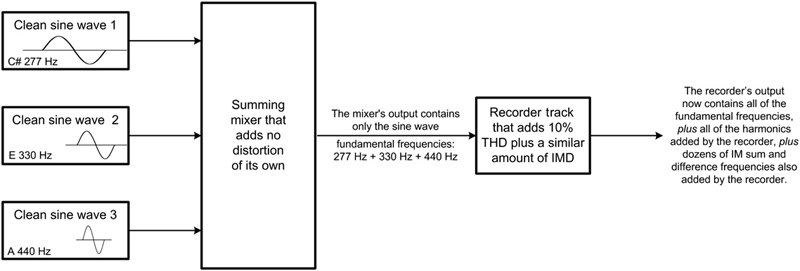
A related myth is that cables and electronic devices must be “broken in” for some period of time before they achieve their final highest fidelity.
Speaker and headphone drivers can change slightly over time due to material relaxation.
But aside from a manufacturing defect, the idea that wire or solid state circuits change audibly over time makes no sense and has never been proven.
This myth becomes a scam when a vendor says that for best results you must break in the product for 90 days. Why 90 days? Because most credit card companies protect your right to a refund for only 60 days.
The Stacking Myth
The last audio myth I’ll debunk is called stacking. The premise is that audio gear such as a microphone preamp or sound card might measure well and sound clean with a single source, but when many separate tracks are recorded through that same preamp or sound card and later mixed together, the degradation “stacks” and becomes more objectionable.
In this sense, stacking means the devices are used in parallel, versus sending one source through multiple devices in series with the output of one sent to the input of the next.
Stacking theory also presumes that when many tracks are recorded through a device having a non-flat frequency response, such as a microphone’s presence boost, the effect of that skewed response accumulates in the final mix more than for each separate track.

However, this type of accumulated coloration is easy to disprove, as shown in Figure 1. As an extreme example, let’s say the preamp used for every track of a recording has a 4 dB boost at 1 kHz. The result is the same as using a flat preamp and adding an equalizer with 4 dB boost on the output of the mixer.
Of course, no competent preamp has a frequency response nearly that skewed. Even modest gear is usually flat within 1 dB from 20 Hz to 20 kHz. But even if a preamp did have such a severe response error—whether pleasing or not—it could be countered exactly using an opposite equalizer setting. So no matter how many tracks are mixed, only 4 dB of EQ cut would be needed to counter the response of the preamp.
Now let’s consider distortion and noise—the other two audio parameters that affect the sound of a preamp or converter. Artifacts and other coloration from gear used in parallel do not add the same as when the devices are connected in series. When connected in series, it is far more damaging because noise and coloration accumulate.
Related, some people believe that two pieces of gear might sound and measure exactly the same, but it’s easier or faster to get a good sounding mix if all the tracks had been recorded through one device versus the other. In truth, recording multiple tracks repeatedly through the same device and then mixing those tracks together later actually reduces distortion compared to mixing the tracks first and going through the device only once.
Even then, any difference between stacking or not is audible only if the device’s distortion is loud enough to hear in the first place. As we learned earlier, where harmonic distortion adds new harmonically related frequencies, IM distortion creates sum and difference frequencies and thus is more dissonant and audibly damaging.
Further, whenever harmonic distortion is added by a device, IM distortion is also added. Both are caused by the same nonlinearity and so are inseparable except in special contrived circuits.
Let’s say you have three tracks, each with a different frequency sine wave. (Yes, music is more complex than three sine waves, but this more easily explains the concept.) For this example we’ll assume the recording medium adds some amount of distortion, but the mixing process is perfectly clean and is not part of the equation.

When each sine wave is recorded on its own track, some amount of harmonic distortion is added. But no IM distortion is added by the recorder because only one frequency is present on each track.
So when the recorder’s tracks are mixed cleanly, the result is three sine waves, each with its own harmonically related distortion frequencies added. This is shown in Figure 2, using the three notes of an A major chord as the source frequencies. For simplicity, only the first two added harmonics are listed for each tone.
Compare that to mixing the three sine waves together cleanly and then recording that mix onto a single track that adds distortion.
Now the recorder’s nonlinearity adds not only harmonic distortion to each of the three fundamental pitches but also adds IM sum and difference frequencies because the three sources are present together when recorded. This is shown in Figure 3.

So by separating out sources across multiple recorder tracks—or converters or preamps or any other devices that might contribute audible distortion—the result is always cleaner than when mixing the sources together first. Note that the difference between THD and IMD distortion amounts is purely a function of the device’s nonlinearity.
With transparent gear the added IM products are not audible anyway—hence the proof that audible stacking is a myth when using high-quality gear. And even when gear is not transparent, stacking can only reduce distortion, which is the opposite of what’s claimed.
